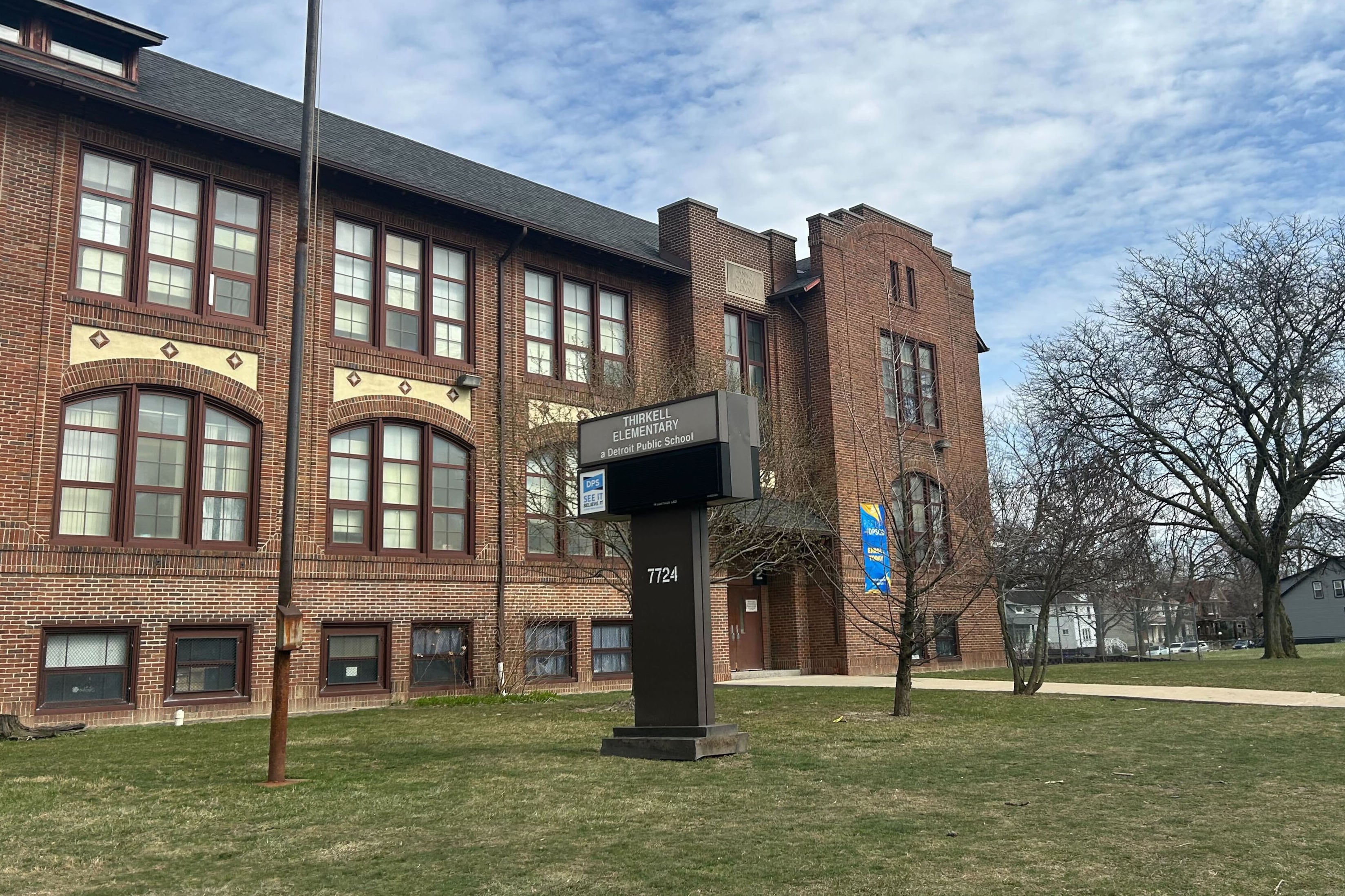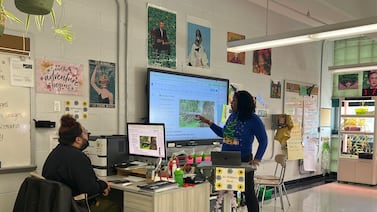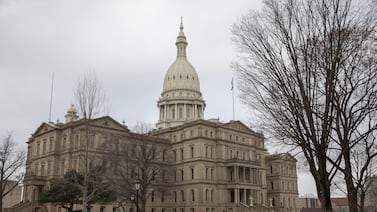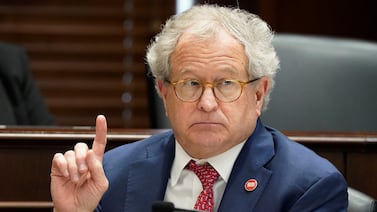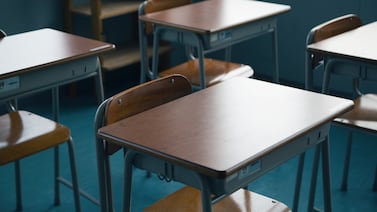Sign up for Chalkbeat Detroit’s free newsletter to keep up with the city’s public school system and Michigan education policy.
Britta Shine’s 7-year-old daughter’s educational journey has been full of changes in the short time she’s been enrolled in the Detroit school district.
Shine’s daughter, who has a mild intellectual disability, started her prekindergarten year at her neighborhood school, Golightly Education Center in the city’s Cultural Center. But after a month, the child was transferred to Thirkell Elementary-Middle School in the New Center area to be part of the school’s special education early childhood program. In the second part of her kindergarten year, her daughter was sent to Sampson-Webber Leadership Academy on Detroit’s west side only to transfer back to Thirkell the following school year.
With the girl set to begin second grade next month, the family will face another change: She will be leaving Thirkell once again to attend Sampson-Webber.
The transfer is part of Detroit Public Schools Community District’s revamp of its special education department, called the Exceptional Student Education, or ESE, department. According to a district presentation, the plan will increase the number of self-contained classrooms, where students with disabilities receive instruction from a special education teacher for most of the day, in the fall from 174 to 185 classrooms. Self-contained classes are designed for students to get the services they need while still attending general education schools.
However, services will be offered in fewer schools, going from 60 to 38. This means some students will have to transfer in August to one of the new sites that offers a program specifically for their disability. The programs include:
- Autism Spectrum Disorder, or ASD
- Early Childhood Program, or ECSE
- Emotional Impairment, or EI
- Deaf or Hard of Hearing Program, or DHH
- Mild Cognitive Impairment, or MICI
- Moderate Cognitive Impairment, or MOCI
- Physical Health or Other Impairment, or POHI
- Visual Impairment, or VI
Last school year, DPSCD served 2,092 students in self-contained classroom programs, according to the presentation. (The figure does not include the students served in the district’s six center-based program sites for students with disabilities that require more support, nor does it include students at general education schools who receive some services, such as speech language therapy.)
One goal of the restructuring is to ensure every special education classroom is fully staffed with teachers and support staff. A second is to reduce travel time for families by offering programs in their high school feeder pattern — the school they would be assigned to based on where they live, Superintendent Nikolai Vitti said at a June school board meeting.
“Those [ESE] programs since I’ve started as superintendent, have been scattered throughout the city and often, a student would have to attend up to four different schools from pre-K to 12th grade, depending on where those programs were at,” he said. “So, the changes were about limiting those to two [schools]. Students would go to a pre-K to eighth grade program in one building and obviously, when they’re done in eighth grade, they go to high school. By being closer to their home, it means it will be easier to transport students every day, which should lead to students coming to school every day and therefore, improving achievement.”
Additionally, the plan will offer five-days-a-week programming for pre-K students, ensure pre-K-8 students can remain at their school, and
increase wraparound services like counseling support and physical, speech, and occupational therapies.
Vitti later told BridgeDetroit in an emailed statement that 1,034 students will receive a placement closer to their homes, reducing the average distance from their homes to school in half.
The proposal was introduced at a March DPSCD academic committee meeting and the district began notifying parents, teachers, and paraprofessionals in April about the changes, Vitti said in the June meeting.
“By reducing the number of programs and concentrating them geographically throughout the city, we can ensure they have certified teachers,” he said. “The more programs we have, even with the few numbers of students in them, makes it harder and harder to staff.”
While Shine isn’t upset about the new changes to the department, she’s disappointed that her daughter’s learning keeps getting disrupted, she said.
The 7-year-old was in a program at Thirkell for students with mild cognitive impairment, which was one of 20 such programs that closed across the district at the end of the school year. As a child formerly in foster care and someone with attachment and trauma disorders, constantly being moved around to different schools is not good for her daughter’s mental health, Shine said.
“It’s not helpful for any child to be uprooted from what they understand and placed in a new environment,” she said. “It’s certainly not helpful for children who have experienced out-of-home care, foster-home placement, any kind of disruption to be abruptly moved without any kind of preparation. At least I know Sampson-Webber. The adjustment period will probably be very difficult, and I’m not looking forward to it.”
Finding a way to accommodate more special education students
In addition to reducing travel time for families, the realignment plan was created to accommodate the growing number of special education students, according to the district presentation. In fiscal year 2017, there were 8,234 special education students in DPSCD. While enrollment dipped to 6,884 in 2023 due to the pandemic, the number of special education students in the district is rising again. For fiscal year 2024, enrollment was 7,132 students; 2025 enrollment is projected to be about 7,708 students.
This follows a growing trend in Michigan and nationwide, with more students receiving special education services since the pandemic. For the 2023-24 school year, there were 217,569 students enrolled in special education statewide, according to the Michigan School Data website. This is compared to 209,937 students during the 2022-23 school year and 203,585 students during the 2021-22 school year.
In the last decade, the percentage of students in special education nationally has increased from about 13% of the total student population in the 2011-12 school year, to almost 15% in 2021-22, as reported Education Week. In 1976-77, students in special education made up 8% of the overall student population.
During the pandemic, the number of students with individualized education programs, or IEPs, dropped by 0.1% between 2019-20 and 2020-21, going from 7.3 million to 7.2 million students, according to the National Center for Education Statistics. However, by 2022-23, that figure rebounded, reaching an all-time high of 7.5 million students, or 15% of all public school students.
The most common type of disability category under the Individuals with Disabilities Education Act is “specific learning disability,” which includes students who have difficulty reading, writing, or doing math, according to Education Week. The disabilities are often called dyslexia, dysgraphia, and dyscalculia, respectively. The second most common is a speech or language impairment, with the third being a chronic or acute health problem that affected a child’s education performance.
Some of the new school sites for students with mild cognitive impairment include Sampson-Webber, Hutchinson Elementary-Middle School and Central High School. New school sites for students with autism include Noble Elementary-Middle School, Garvey Academy, and Cody High School.
Vitti told BridgeDetroit that the district determined which schools would be special education hubs by reviewing student data to see where students were living compared to which schools they were attending for their programs. Then officials looked at schools in those neighborhoods to determine seat capacity to add or shift self-contained seats and programs.
Due to the expansion of self-contained classrooms, sites will have supplemental services, such as a fully assigned ESE ancillary staff including social workers, occupational therapists, speech therapists, and nurses, according to the presentation. Additional paraprofessionals also will be in school buildings to cover absences and/or support crisis responses.
Staff will be assigned based on the programs they serve and the IEP requirements of the students, Vitti told BridgeDetroit.
“Those hubs will have a separate assistant principal, lead teacher, parent liaison so that we can improve the completion of IEPs so that those are more timely,” Vitti said at the meeting.
For years, advocates and parents have complained about delays in conducting or complying with evaluations for special education services in DPSCD.
Teachers and staff who worked in special education programs that closed at the end of the school year will be transferred to the new hubs in the fall, according to the presentation.
In terms of funding, the district receives local, state, and federal funding to support such programs. That includes:
- $45 million in local funding through the Wayne Regional Educational Service Agency, including $8 million in one-time revenue
- $97 million from the state
- $24 million from the federal government, including $9 million of Medicaid revenue
President Donald Trump’s budget bill that passed earlier this month includes significant cuts to health care spending, including Medicaid. Vitti said as families lose Medicaid eligibility, the district’s reimbursement rates will decline.
“We expect this to happen over time as the work rules are implemented,” he said. “We are also waiting to see what happens with state funding, and how the state plans to support our neediest families and students and if they plan to shift funding from K-12 to fill gaps for disadvantaged families.”
Communication is a key part of changes
Shine said another reason why she has been frustrated with the rollout of the new restructuring plan is a lack of communication from the district. Shine received an email from DPSCD on June 2 informing her that her daughter will be returning to Sampson-Webber next school year.
“That’s the only email I ever got,” Shine said. “Overall, I respect what they’re trying to do. My problem is the way in which it was handled. If you’re going to radically change the schooling experience of special education students, you don’t send one email, you don’t even send two emails or five emails or make phone calls. You find a way to make it make it a softer landing, rather than like, ‘Your life is different now.’”
Board Vice President LaTrice McClendon also raised those concerns at the June meeting, saying she received several calls from parents that had not heard about the restructuring of the special education programs.
In response, Vitti said the district had an engagement process for the new plan, which included talking to teachers and paraprofessionals and hosting a parent meeting in April.
“From there, the ESE department has called every parent on the phone and every parent received a letter regarding the possible changes,” Vitti said. “We’re problem-solving with parents, explaining why the changes.”
Vitti told BridgeDetroit that the district also sent robocalls and is now starting to conduct home visits to any families staff have not reached.
Shine tried explaining to her daughter that she will be going to a new school next year, but it’s hard for her to understand, she said.
“For her, and I assume for lots of other children, too, it’s going to come as a big, weird surprise,” Shine said. “I am very grateful it’s going to be Sampson-Webber, which is a building that she knows. If she sees me driving there, she’ll figure out, ‘OK, I remember this building.’’
Shine hopes that the teaching team that worked with her daughter at Thirkell will be there to help her at Sampson-Webber in the fall to make the move a little easier.
“When the school year starts, give the students some grace when they have their natural reactions to these radical changes for them,” she said.
Micah Walker is a reporter with BridgeDetroit. You can reach her at mwalker@bridgedetroit.com.

